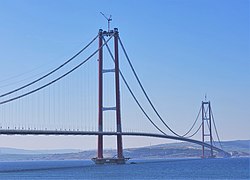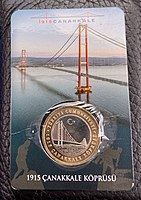1915 Çanakkale Bridge
1915 Çanakkale Bridge Dardanelles Bridge 1915 Çanakkale Köprüsü Çanakkale Boğaz Köprüsü | |
|---|---|
 Çanakkale bridge, nearing completion, March 2022 | |
| Coordinates | 40°20′24″N 26°38′10″E / 40.34000°N 26.63611°E |
| Carries | 6 lanes of Maintenance walkways on each side |
| Crosses | Dardanelles |
| Locale | Çanakkale Province, Turkey |
| Official name | 1915 Çanakkale Köprüsü |
| Website | 1915canakkale |
| Characteristics | |
| Design | Suspension |
| Total length | 4,608 m (15,118 ft) |
| Width | 45.06 m (148 ft) |
| Height | 334 m (1,096 ft) |
| Longest span | 2,023 m (6,637 ft) |
| Clearance below | 70 m (230 ft) |
| History | |
| Designer | COWI A/S and PEC (Pyunghwa Engineering Consultants) |
| Constructed by | Daelim, Limak, SK, Yapı Merkezi[1] |
| Construction start | March 2017[2] |
| Construction end | 26 February 2022 |
| Opened | 18 March 2022 |
| Statistics | |
| Toll | ₺280[3] |
| Location | |
 | |
The 1915 Çanakkale Bridge (Template:Lang-tr) is a road suspension bridge in the province of Çanakkale in northwestern Turkey. Situated just south of the coastal towns of Lapseki and Gelibolu, the bridge spans the Dardanelles, about 10 km (6.2 mi) south of the Sea of Marmara.[2] The bridge is the longest suspension bridge in the world—with a main span of 2,023 m (2.023 km; 1.257 mi), the bridge surpasses the Akashi Kaikyo Bridge (1998) in Japan by 32 m (105 ft).[4][5][6]
The bridge was officially opened by President Recep Tayyip Erdoğan on 18 March 2022 after roughly five years of construction.[7] It is the centrepiece of the planned 321-kilometre long (199 mi) US$2.8 billion O-6 motorway, which will connect the O-3 and O-7 motorways in East Thrace to the O-5 motorway in Anatolia.[8] The year "1915" in the official Turkish name honours an important Ottoman victory in the Gallipoli campaign against firstly a naval engagement followed by a land invasion on the Gallipoli peninsular by the forces of Australia, New Zealand (The ANZACS), France and Great Britain from the 25th April 1915 which were largely evacuated by December of that year.
The bridge is the first fixed crossing over the Dardanelles[9] and the sixth one across the Turkish Straits, after three bridges over the Bosphorus and two tunnels under it.[10]
Design and cost
The bridge's tender project was designed by Tekfen Construction and Installation and detailed designed by COWI A/S[11] and Pyunghwa Engineering Consultants (PEC) in South Korea (for cable design and approach bridge design packages only). Arup and Aas-Jakobsen participated in the project as Independent Design Verifier (IDV). The Administrator consultants are Tekfen[12] and T-ingénierie.
The total length of the bridge is 3,563 m (11,690 ft) and together with the approach viaducts the length reaches 4,608 m (15,118 ft), which surpasses the total length of the Osman Gazi Bridge and its approach viaducts by 527 m (1,729 ft), to become the longest bridge of any type in Turkey.[13]
The height of the bridge's two towers is 334 m (1,096 ft),[note 1] making it the tallest bridge in Turkey, surpassing Yavuz Sultan Selim Bridge, and the third tallest structure in the country. Internationally, the bridge is the second tallest bridge in the world, surpassing the Pingtang Bridge in China. The deck of the bridge is 72.8 m (239 ft) high and 45.06 m (147.8 ft) wide, with a maximum thickness of 3.5 m (11 ft). The deck carries six lanes of motorway (three in each direction), together with a walkway on each side for maintenance.[13]
According to President Erdoğan, the bridge cost 2.5 billion euros (2.7 billion US dollars) to build, but would save €415 million ($458 million) per year from a reduction of fuel consumption and carbon emissions.[14]
History
Proposals for a bridge spanning the Dardanelles Strait[15] have existed since the 1990s. A bridge was proposed again in 2012, and in 2014, it was placed in the Turkish government's future transportation projects list.[16] In September 2016, the government officially launched the bridge building project.[16] Bids for the contract to construct the bridge were made in 2017.[17] The contract was awarded to a consortium containing Turkish companies Limak Holding and Yapı Merkezi, alongside South Korean companies DL Holdings and SK Ecoplant.[18]
Construction began in March 2017.[19] The bridge was initially scheduled for completion in September 2023,[18] and later brought forward to March 2022.[19] On 16 May 2020, the second tower was completed, on the Gallipoli side (European coast).[20] By 13 November 2021 all block decks were installed.[7] The toll bridge opened for traffic on 18 March 2022, with a toll price of 200 lira (€6.78).[14]
A Chinese consul general Zhang Meifang uploaded a video to social media on 13 Feb 2023 that inaccurately claimed the bridge in Turkey withstood the recent devastating earthquake thanks to Chinese technology. Zhang wrote, "The bridge built by China in Turkey’s withstood the earthquake #ChinaTech." She also falsely claimed that "a subsidiary of Shudao Group is the sole participant in the construction." The bridge was also unlikely to be in any danger from the devastating magnitude 7.8 earthquake that struck Turkey's southeastern provinces on 6 Feb 2023, as it is located approximately 950 kilometers (590 miles) northwest from Kahramanmaraş, the city closest to the quake's epicenter.[21]
Symbolism
Some symbolic figures are associated with the bridge:
- the number 1915 in the name,
- the height of intersection point of main cable (318 m),[22]
- and the opening date (18 March),
are all related to the date of the Ottoman naval victory, on 18 March 1915, during the naval operations in the Gallipoli campaign. Meanwhile, the length of the bridge's main span (2,023 metres) refers to the centennial of the Turkish Republic (1923–2023).[8]
Gallery
- Under construction
-
Western tower, March 2020
-
View from European side to Asian side, March 2020
-
The bridge near completion
-
A video from the bridge in March 2022
-
1915 Çanakkale Bridge Commemorative Coin
Comparison of notable bridges
See also
- Osman Gazi Bridge
- Istanbul Canal
- Other crossings of the Turkish Straits:
- Bosphorus Bridge
- Eurasia Tunnel, undersea tunnel, crossing the Bosphorus for vehicular traffic, opened in December 2016
- Fatih Sultan Mehmet Bridge
- Great Istanbul Tunnel, a proposed three-level road-rail undersea tunnel
- Marmaray Tunnel, undersea rail tunnel connecting the Asian and European sides of Istanbul
- Yavuz Sultan Selim Bridge
- Xerxes' Pontoon Bridges, an ancient attempted crossing at a similar location (480 BC)
Notes
- ^ 318 m is elevation of IP (Intersection Point) of main cable which is important for design, actual tower height considering tower top enclosure is 334 m.
References
- ^ "Four consortia in $2.6 bln Dardanelles bridge bid". Hürriyet Daily News. Anadolu Agency. 26 January 2017. Archived from the original on 4 February 2017. Retrieved 26 May 2017.
- ^ a b "Canakkale 1915 Bridge". Road Traffic Technology. Archived from the original on 6 January 2018. Retrieved 6 January 2018.
- ^ "Cumhurbaşkanı Erdoğan, 1915 Çanakkale Köprüsü'nün geçiş ücretini açıkladı". ntv.com.tr (in Turkish). NTV. 18 March 2022. Archived from the original on 18 March 2022. Retrieved 18 March 2022.
- ^ "Why Turkey Built the World's Longest Suspension Bridge". The B1M. Retrieved 22 May 2022.
- ^ Tim Gibson (11 May 2022). "Turkey Has Built the World's Longest Suspension Bridge". The B1M.
- ^ "Groundbreaking ceremony for bridge over Dardanelles to take place on March 18". Hürriyet Daily News. 17 March 2017. Retrieved 22 May 2022.
- ^ a b "Turkey opens record-breaking bridge between Europe and Asia". CNN. 18 March 2022. Archived from the original on 20 March 2022. Retrieved 19 March 2022.
- ^ a b "Groundbreaking ceremony for bridge over Dardanelles to take place on March 18". Hürriyet Daily News. 17 March 2017. Archived from the original on 18 March 2017. Retrieved 19 March 2017.
- ^ "Turkey inaugurates 1st bridge over Dardanelles Strait-Xinhua". www.xinhuanet.com. Retrieved 20 March 2022.
- ^ "Bosphorus Strait | All About Turkey". www.allaboutturkey.com. Retrieved 20 March 2022.
- ^ "Cowi Canakkale". Archived from the original on 20 March 2022. Retrieved 15 May 2018.
- ^ "Çanakkale to be site of Turkey's longest bridge". Hürriyet Daily News. 28 January 2012. Archived from the original on 20 March 2022. Retrieved 11 January 2017.
- ^ a b ERM (December 2017). Çevresel ve Sosyal Etki Değerlendirmesi (ÇSED) Raporu – 1915 Çanakkale Köprüsü ve Malkara-Çanakkale Otoyolu Projesi (PDF) (Report). ERM. Archived from the original (PDF) on 31 August 2018. Retrieved 31 August 2018.
- ^ a b "Turkey builds massive bridge linking Europe and Asia". AP NEWS. 18 March 2022. Archived from the original on 18 March 2022. Retrieved 20 March 2022.
- ^ "World's Longest Suspension Bridge Takes Shape in Turkey". Engineering News-Record. 29 September 2021. Retrieved 22 March 2022.
- ^ a b "A bridge on Çanakkale Strait finally in the works". Daily Sabah. 2 September 2014. Retrieved 22 March 2022.
- ^ "Four consortia in $2.6 bln Dardanelles bridge bid". Hürriyet Daily News. 26 January 2017. Retrieved 22 March 2022.
- ^ a b "Turkey Starts Dardanelles Suspension-Bridge Project". Engineering News-Record. 28 March 2018. Retrieved 22 March 2022.
- ^ a b "Towers complete on world's longest suspension bridge". New Civil Engineer. 7 September 2020. Retrieved 22 March 2022.
- ^ "Last steel block placed in Çanakkale 1915 Bridge". hurriyetdailynews.com. 16 May 2020. Archived from the original on 20 October 2020. Retrieved 13 July 2020.
- ^ "Chinese diplomat deletes inaccurate post about bridge in Turkey". koreajoongangdaily.joins.com. 14 February 2023. Retrieved 17 February 2023.
- ^ "1915 Çanakkale Köprüsü'nün 318 metrelik çelik kuleleri tamamlandı". A Haber (in Turkish). Archived from the original on 24 May 2021. Retrieved 24 May 2021.
External links
- Official website
- Çanakkale 1915 Bridge Archived 4 November 2020 at the Wayback Machine at Daelim web site






